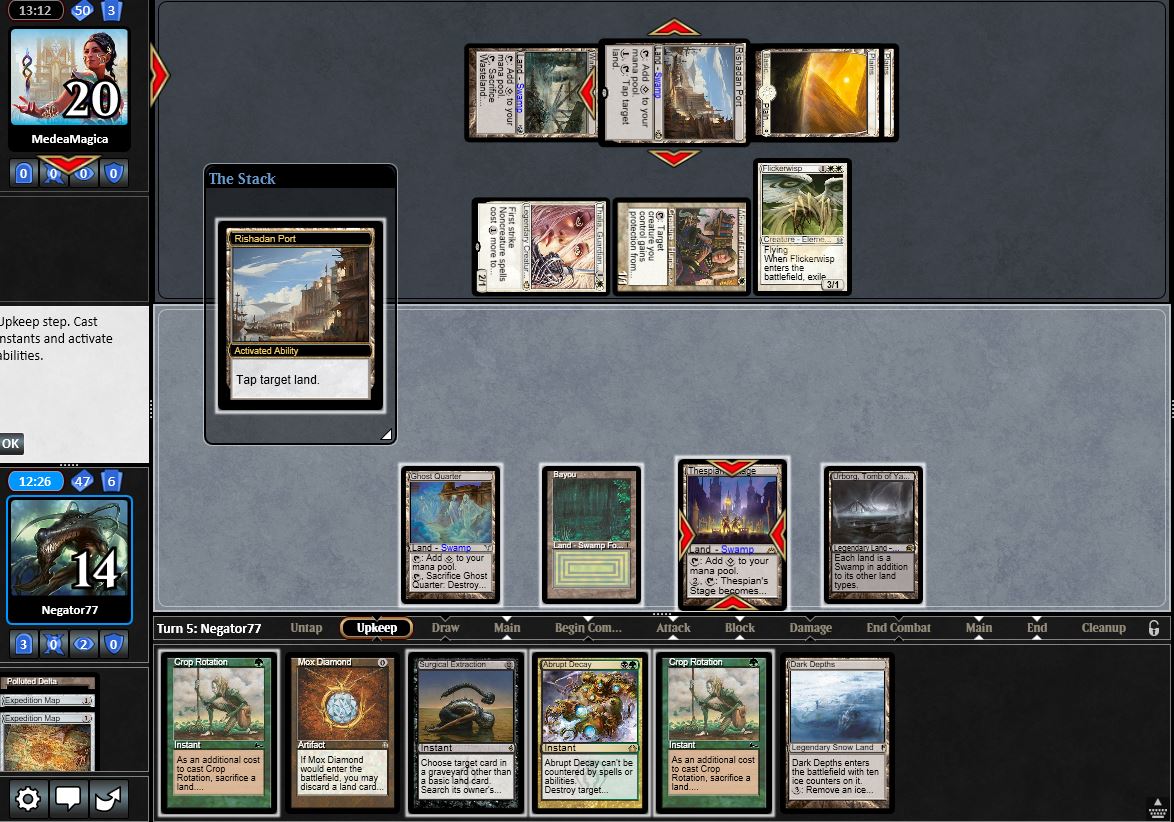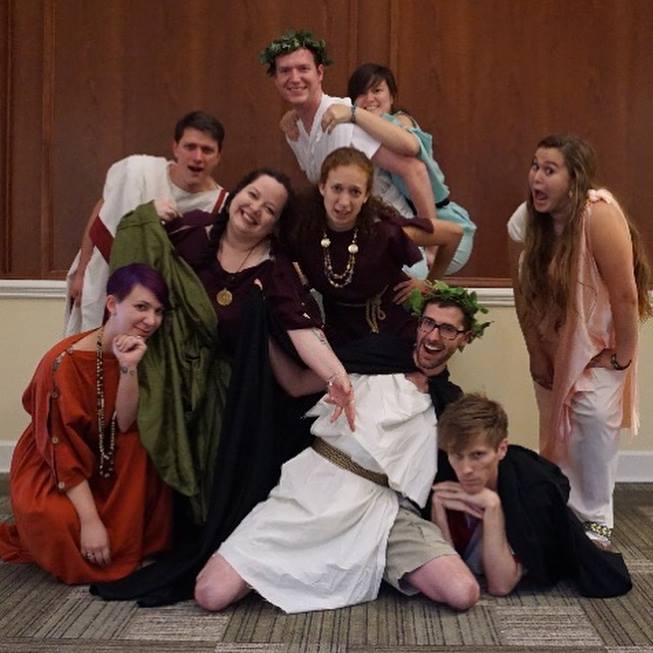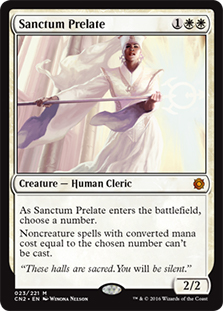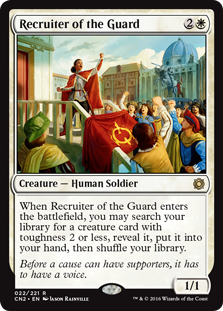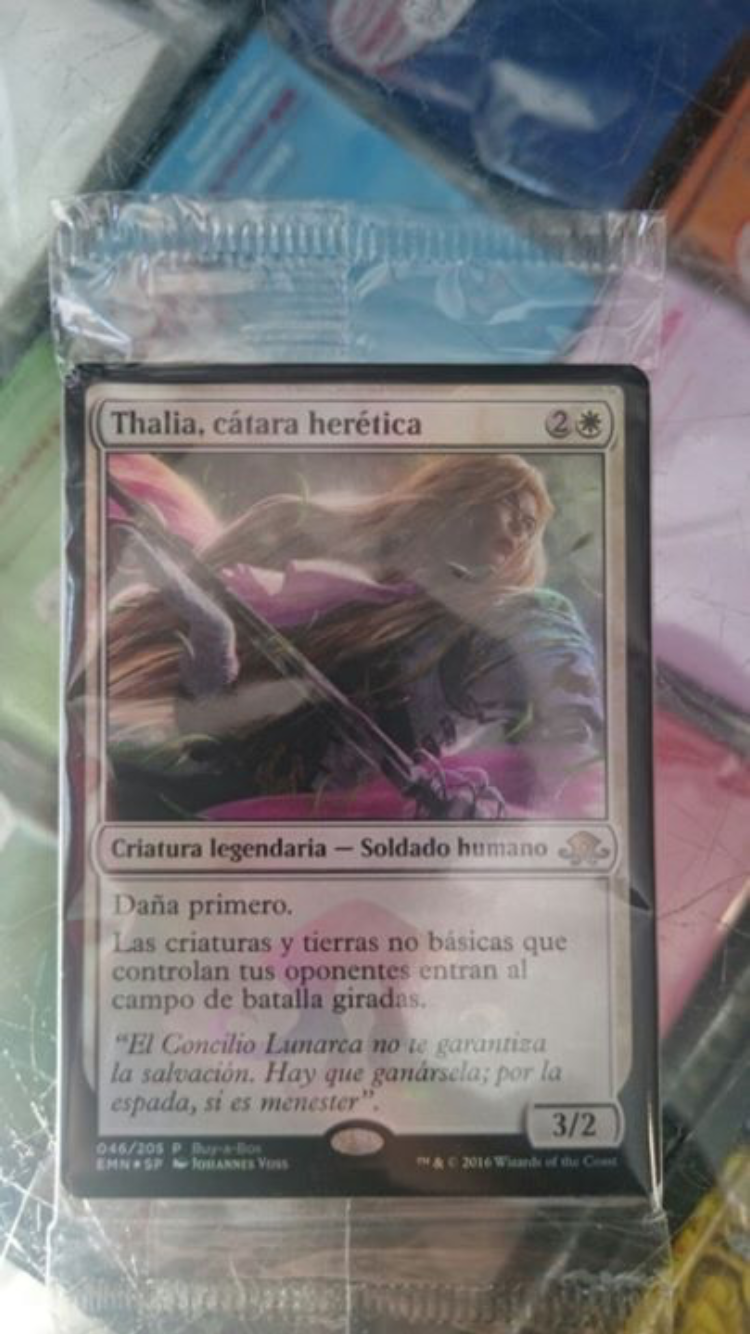I came. I saw. I made my opponents’ noncreature spells cost one more mana. I had been testing extensively for GP Louisville since about November, although a number of factors (travel, work, holidays) kept me from producing much content in the last few weeks. I took off Friday and Monday from work (a big deal in the world of teaching, let me tell you) to take full advantage of this GP experience. I was setting myself up for a good run for a GP, or a fine vacation in Louisville if that didn’t pan out. Here’s the list I submitted Friday afternoon:
D&T 1/9/17
I’m not going to talk about why I made the deck choices I did, changes I want to make to the deck, or compare my list to Craig Wescoe’s list (That will be a separate article later this week, don’t worry!). Today is just going to be my tournament report, which is actually going to begin with Thursday night.
I ran my list through a small Eternal Extravaganza 4-rounder satellite on Thursday night to just make sure that the list felt solid. Spoilers, it felt just about perfect.
2-0 vs Shardless
2-0 vs Eldrazi
1-2 vs ANT
2-1 vs D&T
A couple of interesting things came up in this little event. The first is how Banisher Priest and Fiend Hunter differ. If Fiend Hunter is removed with the trigger on the stack, the creature will be exiled forever. If Banisher Priest is removed with the trigger on the stack, the creature never leaves play. My Eldrazi opponent had a creature equipped with Jitte. My opponent could have used Jitte counters to remove the Banisher Priest with the trigger on the stack, and his creature would never have left play; then he wouldn’t have had to pay two mana to reequip his Jitte. Instead, my opponent let the trigger resolve, then killed my creature, causing his creature to blink in and out of play. Paying that two mana the following turn to equip Jitte again likely cost him the game in the long run, as it was a big tempo swing. The little interactions really matter!
Secondly, Sword of Light and Shadow is garbage. My opponent fetched it up in the mirror, and I just killed them before it had time to matter. SoLaS is very slow to get active, and it’s actually rare that both sides of the trigger actually happen. In the matchups where you would want it for protection (Maverick, the mirror, Miracles, Stoneblade), the primary forms of removal don’t put creatures into the graveyard. They instead sent creatures to exile (e.g. Swords to Plowshares, Path to Exile, Council’s Judgment) or to the library (i.e. Terminus). It’s much better to play Sword of War and Peace, which has extreme upsides. More on that soon…
Finally, make your opponent play it out when they are comboing off. Always. My ANT opponent cast an Ad Nauseum with a storm of five and at least seven cards in graveyard, one of which is a Cabal Ritual. My opponent stops after revealing land, land, Cabal Ritual, Dark Ritual, Dark Ritual, Gitaxian Probe, Tendrils of Agony, and Chrome Mox. My opponent stops because they think they have the line of imprint Gitaxian Probe on Chrome Mox, cast the three rituals, and cast Tendrils of Agony for exactly twenty. I then stop my opponent, and review their graveyard, as I have Surgical Extraction in hand. This is where things get fun.
I cannot Surgically Extract Cabal Ritual. If I do so, I add one to the storm count and lose two life, meaning my opponent can Tendrils me without the Cabal Ritual. My opponent actually stopped too early (they had three life left when they stopped). If you look at the above scenario again, my opponent actually does not have an initial black mana unless they imprint one of their rituals. Uh oh! Given that I reviewed their graveyard, my opponent assumes I have Surgical. Thus, my opponent has to imprint the Cabal Ritual, Gitiaxan Probe, and hit a castable spell that is either free or costs exactly one black mana. If they do not, they are deal to my board. Unfortunately, my opponent hits the Disfigure and wins the game at one life. *shrug*
Anyway, this is supposed to be a GP report, but my rounds before the event were interesting enough to discuss. Here’s the abridged version:
0-2 vs UW Stoneblade
2-1 vs Nic Fit (Siege Rhino version)
0-2 vs Burn
2-0 vs UR Delver
2-0 vs Red Stompy (Chandra, Torch of Defiance, Thunderbreak Reagent)
2-1 vs Burn
2-0 vs D&T
0-2 vs D&T
2-0 vs D&T
2-1 vs Dredge
2-0 vs 4-color Delver
2-0 vs Omni
2-0 vs Miracles
2-1 vs Eldrazi
ID vs Miracles
I’m not going to write up everything, but here are the notable things and explanations of my losses.
Round 1: 0-2 vs Stoneblade:
Have you ever looked at your Planeswalker Points page and said, “Crap, I’m just short of byes again?!?!” Yeah, me too. In retrospect, I should have gotten off my butt and attended another GP to play side events and rack up the Planeswalker points I needed for my byes. Sometimes the biggest mistakes you make actually happen before the event begins. I lose game one to an unchecked Jace with a follow up Council’s Judgmentfor my Sword of Fire and Ice. I lose game two by flooding out. My opponent is at six life, I have a Mirran Crusader and a Sword of War and Peace. He has a True-Name Nemesis. I need a flier, a Council’s Judgment, Sword of Fire and Ice, a Mother of Runes, or any two creatures to push the final points of damage. I proceed to draw lands for the rest of the game. This was the only round I lost due to the deck failing to deliver cards. I start my day in the crap bracket, which is not where you want to be when your deck is built to beat the top tier of the metagame.
Round 2: 2-1 vs Nic Fit
Nic Fit is a pretty bad matchup. They have bigger threats than we do, a sweeper in the form of Pernicious Deed, and our mana denial package lines up poorly against their basic lands and creature-based threats. Sigarda, Host of Herons is also a beating, as Council’s Judgment is our only real out. I win game two by swinging for 18 damage with a Mirran Crusader wielding a Sword of War and Peace. This happens two more times during the event, and is another reason I advocate SoWaP over SoLaS.
I win game three when my opponent has a brain fart. They have 8 mana and top deck a Pernicious Deed, I have a board with about three critters and a Batterskull. Normally, it is correct to sit on Deed and pop it during your opponent’s turn for maximum effect. In this instance, my opponent needed to do it on their turn. I was able to bounce my Batterskull back to my hand and redeploy it, vastly improving my clock. My opponent realized their mistake immediately after passing the turn, but the damage was done.
Round 3: 0-2 vs Burn
I am at three life. I am presenting lethal and have a Thalia in play. I have two Plains and a Rishadan Port as lands. My opponent has one card in hand and controls three Mountains. I know my opponent does not have a creature in hand or a spell they can cast for a single mana (e.g. Fireblast). My opponent’s final card is very likely one of the following: land, Price of Progress, or Sulfuric Vortex. I have two options: 1. Play Port two and double Port my opponent during their upkeep. 2. Play another Plains and commit another relevant card to the board (notes don’t say what), and Port my opponent a single time. Playing a Port leaves me dead if my opponent’s final card is Price of Progress. Not playing a second Port will leave me dead to any 2 mana source of damage (e.g. Flame Rift) if my opponent does indeed currently have a land in hand. I am dead to a one mana direct damage spell no matter what if my opponent’s card is a land. Sulfuric Vortex is irrelevant currently since I am at three life. What’s the play?
Based on my opponent’s banter while sideboarding, I am aware that he keeps Price of Progress in for this matchup. If my opponent has Price, he likely will not have cast is for two damage yet, as it will likely become lethal if he holds out a bit longer. His mana has also been taxed by Thalia, furthering the case that he might indeed have Price. If my opponent is playing Price, he likely currently has four in the deck. I guess that there are likely less than four copies of two mana direct damage spells in his deck, and accordingly, I opt to play a Plains and Port him a single time. His card in hand was a land, but his draw for the turn was Searing Blaze. I lose. Whomp, whomp.
Rounds 7-9: The Mirror Gauntlet
I don’t know that the coverage accurately reflected how much D&T was in the room. When I finished my rounds, I walked over a table or two and stopped at the first D&T match I saw. It was great chatting with all of you. Anyway, to sum up these rounds, my notes on the matches show a trend: the mirror is won by getting a mana advantage or an equipment advantage. An unchecked Vial gives you tremendous tempo. Checking your opponent’s Vial might make your opponent stumble enough where you gain an insurmountable advantage, especially if they don’t have access to two white mana. If you fall behind in the equipment war, your resources go towards not letting your opponent connect with said equipment. You are forced to Recruiter for Revokers or Flickerwisps to buy time. Your opponent is then free to advance their board and tutor for more Stoneforges or other relevant cards. In both of the games I dropped to the mirror, my opponent won the equipment war early, and I was not able to win said resource war.
Round 10 vs Dredge
If your opponent takes no play on turn one, they likely have Firestorm or Nature’s Claim in hand. Don’t feel like you need to run out a Mom or Rest in Peace into one of those immediately. Not ramming my RiP into Nature’s Claim seals the deal for me in game three of this round.
If you have Surgical Extraction, Bridge from Below is usually going to be your best target. I know there is a temptation to snipe their first dredge card, but that’s usually not going to work out long term. You can beat Ichorid, Prized Amalgam, and Narcomeba beatdown easily; however, beating a bunch of zombie tokens that also provide fuel for Cabal Therapy and Dread Return is much trickier. I (effectively) win games two and three of this matchup by extracting Bridge, making it very difficult for my opponent to push damage.
Round 13 vs Miracles
Gideon, Ally of Zendikar is generally a token machine vs Miracles. You typically don’t want to plus Gideon, as it’s extremely bad for it to eat a Plow. Luckily for me, my Miracles opponent taps out while I have Gideon in play. I plus Gideon and swing with him and the token, quickly bringing my opponent from ten to three. I think my opponent was so used to Gideon just creating tokens every turn that he didn’t imagine it would do anything else. Whoops, there go a few turns off the clock!
Round 15 ID vs Miracles
So, at the end of round 14, I am sitting at a relatively strong 11-3. I’m ready to play one more round of Magic for a shot at great prizes. The problem, however, is that I have the literal worst tiebreakers of the 33 pointers. I am in 60th place, and 33 pointers go up to 21st place (thanks, round one loss!). This means that it unlikely that I will make it to the next prize tier even with a win. I didn’t get to see the standings (they weren’t easily accessible online), so my opponent informed me of our situation and I accepted his offer for an intentional draw after he takes a minute or two to walk me through the math. I wasn’t super comfortable with it at first, as I didn’t see the standings myself, but he was 100% correct that it was better for us to draw. We guaranteed $500 of prizes between the two of us instead of $250 with an outside shot at $500 for one of us. Retroactively, I can say that I would have ended up in about 36th place if I had played out the round.
The Wrap Up
I ended up going 11-3-1 and got 48th place at this GP, my best GP finish to date. If I add in the event I played Thursday night, that’s a total record of 14-4-1 for the weekend. Given that this GP had 1600+ people, that’s a pretty great feeling. I’ve cashed more IQs than I can count, a couple of Opens, and a few larger events like the Eternal Extravaganza events, but I hadn’t done anything notable with GPs other than make day 2 and whiff on my win-and-cash rounds. Looking back at my performance in this event, I can really see how much I’ve grown in the last year or two. As a Legacy specialist, I don’t have very many chances in a year to really prove myself; every event really mattered to me. There was a period of time where I really felt entitled to wins given how much work I put into the format and how much more experience I had than my average opponent. I was nervous when I got paired against a pro. I had periods of relative depression and insecurity where I waffled on my deck choice or questioned my own ability. That’s all gone now.
I lost round one of the event that mattered most to me this year. I didn’t flinch. I wasn’t mad. I kept playing and fought my way through the ranks until I was back at the top tables. I didn’t get nervous in my win-and-in match for day two. I went undefeated on day two, and that fact didn’t go to my head. More importantly, I successfully played the event one round at a time without taking my losses hard or focusing too much on how many more wins were necessary to cash. I didn’t flinch when paired against the pros, and honestly, this time around, it was the other people who were nervous when sitting down against me. It might have been the cloak though, not gonna lie…
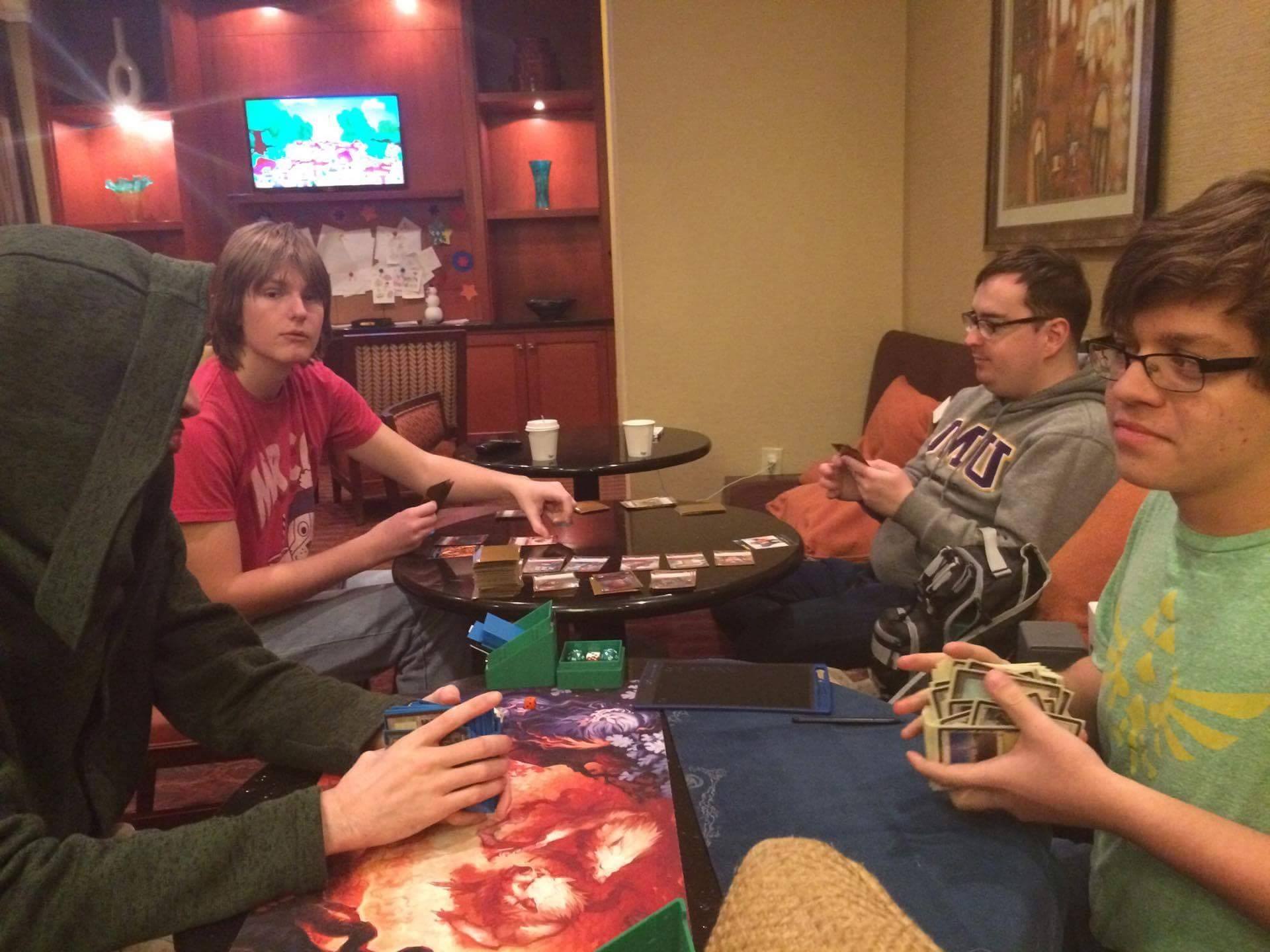
I’d like to give some credit to the people who helped make my event great. Louis Fata and Zach Koch were my primary sounding boards for my 75 immediately before the event, though the regulars at MtG:Salvation and The Source gave me some tips as well. You can only do so much theory crafting and testing on your own; sometimes you just need someone else to affirm your crazy ideas or keep you in check. I’d like to thanks my local testing group group for all the work that went into the preparation for this event as well as driving my lazy butt around all weekend. I’d like to thank Lincoln Baxter for his company over the course of day two (my team decided to go to a distillery since they all scrubbed out) and also congratulate him on his first GP day two with his sweet BUG Lands brew that he’s been polishing and writing about for quite some time.
Finally, I’d just like to thank all the random D&T players that took the time to chat with me. It’s no exaggeration to say that it was the best part of my weekend. It was very validating to have people come up to me and tell me that they started to play this deck because of me or won their matches due to sideboarding advice I gave them. I’d like to thank you all for your donations, amazing stories, and for the great article ideas you gave me. Speaking of, expect that article on how I chose my list for the GP and where I’m going moving forward to drop sometime on Friday.
